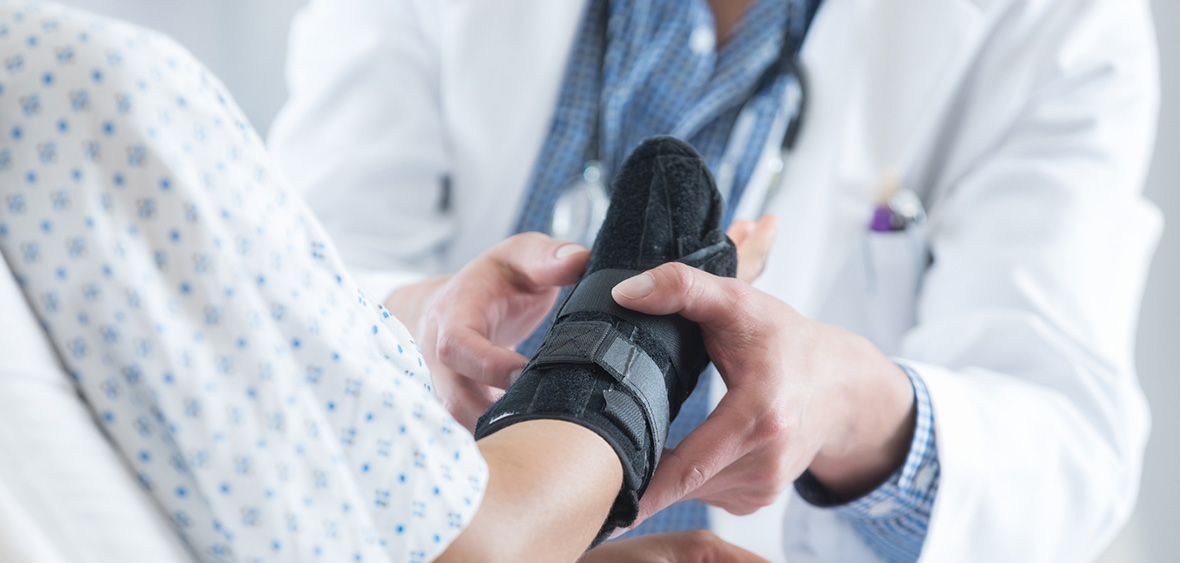
Many people experience a wrist sprain in their lifetime. The ligaments in your wrist are strong, but it is possible for them to tear or stretch too much. Wrist sprains can happen as a result of falls, sporting activities or other movements where the wrist twists or bends, according to the American Academy of Orthopaedic Surgeons.
Types of Wrist Sprains
There are different grades of wrist sprains based on the severity of the sprain:
- Grade 1: This is the mildest grade of wrist sprain, where the ligaments have just been stretched too much.
- Grade 2: This is a moderate wrist sprain, where the ligaments have experienced some tearing. In this sprain, the ability to use your wrist may be reduced.
- Grade 3: This is a severe wrist sprain, where the ligaments are completely torn or detached from the bone. This sprain requires immediate medical attention. Some Grade 3 wrist sprains are accompanied by wrist fractures if ligaments detach from the bone, because a tiny part of the bone can detach along with the ligament.
Symptoms of Wrist Sprains
Symptoms may include:
- Pain and tenderness
- A warm feeling on or near your wrist
- A sensation of tearing or popping in your wrist
- Bruising and swelling
Diagnosis and Treatment
Even if you think you have a mild wrist sprain, if it doesn’t get better within a couple of days, see a medical provider. Your provider can help you get the proper treatment to reduce your risk of issues down the road.
Your provider will go over your medical history with you and ask questions about your injury. Your provider will also conduct a physical examination of your wrist to check for pain and assess its ability to move and conduct a physical examination of your hand and arm to rule out additional injuries. Also, your provider may send you to have an X-ray or another scan, such as an MRI or CT scan, completed.
If your injury is mild or moderate, your provider may recommend that you follow the RICE method:
- Rest your wrist by using it as little as possible.
- Ice your wrist by applying cold ice packs for 20-minute periods multiple times a day.
- Compress your wrist by wearing a compression bandage that provides elasticity.
- Elevate your wrist above your heart when you rest.
For pain, you can take aspirin or ibuprofen.
If you have a moderate wrist sprain, your provider may tell you to wear a wrist splint for a week or longer to keep your wrist from moving. Then your provider may tell you about stretching exercises for your wrist to reduce stiffness and help your wrist get back to normal.
If you have a severe wrist sprain, you may need surgery to reconstruct your ligaments or reattach your ligaments to the bone. If you have surgery, you will likely complete rehabilitation or physical therapy to help your wrist get stronger. Recovery time from surgery can range from six months to a year.
If wrist sprains are untreated, they can lead to:
- Arthritis
- Stiffness
- Chronic pain
Preventing Wrist Sprains
Ways to help prevent wrist sprains include:
- Being careful when walking or running in wet weather
- Wearing protective tape or wrist guards when playing sports
UofL Health is Here for You
Our team of fellowship-trained orthopedic surgeons at UofL Physicians – Orthopedics can provide the best treatment options for minor conditions, as well as the most complex injuries and deformities. Click here to see our Orthopedics locations.
UofL Health – Sports Medicine has expert orthopedic physicians who have specialized training to address all aspects of the musculoskeletal system: bones, joints, muscles, tendons and ligaments. They can help athletes recover and get back in the game with optimal performance. UofL Health also has Sports Medicine Urgent Care at UofL Health – Medical Center Northeast, which provides after-hours care of sports injuries of all types.









